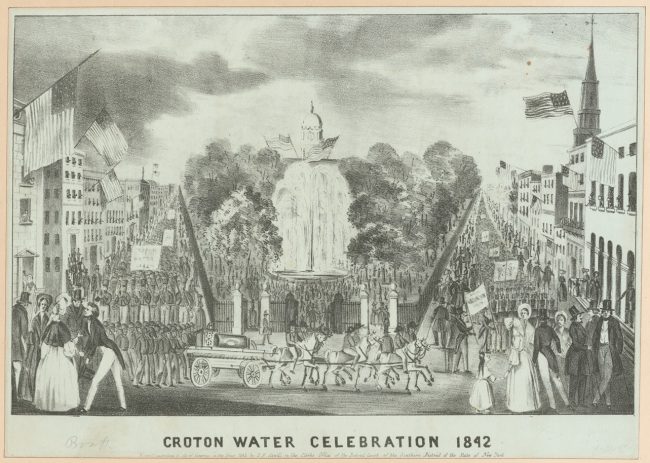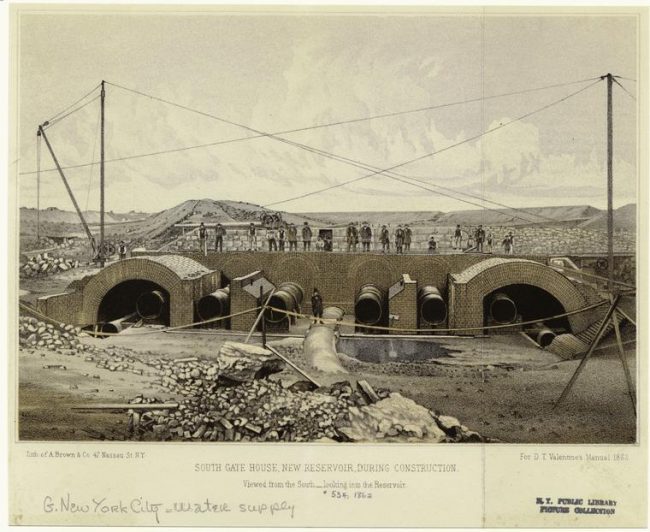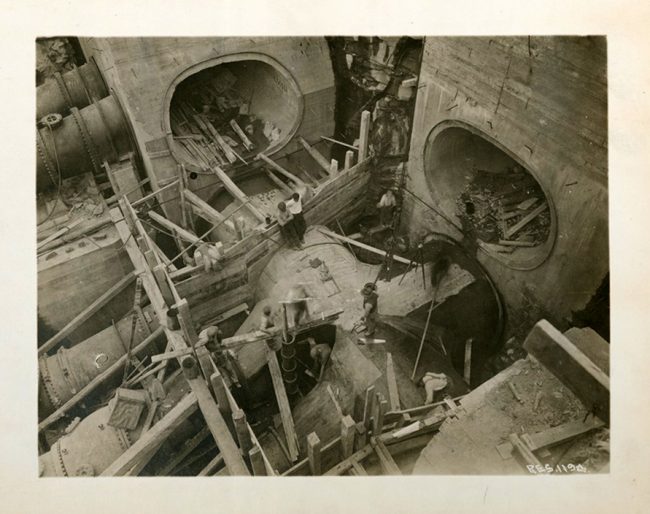
Celebrate ten years of Urban Omnibus and support ten more years of fresh, independent perspectives on citymaking with a donation today!
Celebrate ten years of Urban Omnibus and support ten more years of fresh, independent perspectives on citymaking with a donation today!

Croton Water Celebration, 1842 | Courtesy of New York Public Library
In 2013, Mayor Michael Bloomberg turned a wheel that sent a ceremonial spray of water into a fountain at City Hall Park, echoing a much larger 1842 event in the same place that celebrated the first arrival of water to the city through the Croton Aqueduct. Supplying New York City with a steady stream of clean water is an ongoing effort nearly two centuries in the making. And Bloomberg’s gesture inaugurated the Manhattan section of Water Tunnel No. 3, the largest capital construction project in the city’s history ringing in at a total cost of $5 billion. Initiated in 1970, the expected completion is 2018.
While we rarely see our water system at work — even its most visible manifestation, the Central Park reservoir, is no longer used to distribute our water supply — it remains the city’s most critical piece of civic infrastructure. This past weekend, The Architectural League hosted 5KL: Water, a symposium on issues of water supply in the context of climate change, which included a session exploring historical and contemporary challenges of bringing clean and adequate water to New York City.

Construction of the South Gate House, Central Park, 1862 | Courtesy of New York Public Library
In conjunction with the symposium, the League revisited archival materials on the design and management of New York City’s water supply through an essay and two lectures. Read more about and access those materials below, and stay tuned for full documentation of the 5KL: Water symposium — which also included case studies on Los Angeles and The Great Lakes region — on ArchLeague.org in the coming weeks.
New York’s water supply is the most crucial of the several magnificent systems of civil engineering that make the metropolis possible, and it is the most closely tied to the natural systems of the region. The political and engineering vision and design skill with which the water supply system was created should be a source of enormous pride to New Yorkers. These earlier accomplishments can also serve as example and spur, to encourage us to use the opportunity of further development of the system to improve and embellish our city.
In 1992, The Architectural League partnered with the New York City Department of Environmental Protection and the Parks Council (now New Yorkers for Parks) to organize a design study titled The Productive Park that explored how parks and neighborhood amenities could be coupled with the city’s infrastructure, and how design could contribute to public works.

The Catskill Aqueduct Headworks, 1913 | Courtesy of New York Public Library
Concurrent with the open call for participation in the design study, the League organized an exhibition on New York City’s water supply that surveyed the history of the waterworks, with particular attention to the buildings constructed as part of the system and to the many parks whose existence and form are inextricably connected to it. A catalogue of the exhibit was prepared, though never published, which included a thorough essay detailing the evolution of the Croton, Catskill, and Delaware Systems, and expansions into Brooklyn’s water supply (read more on Brooklyn’s water systems here) and numerous other nearby watersheds. “Waterworks: Architecture and Landscape,” authored by Thomas Cirillo, Rosalie Genevro, and Anne Rieselbach, is now available in its entirety on the League website.
[T]he earliest parts of New York’s supply network — the Old and New Croton Aqueducts and the groundwater system that supplied Brooklyn — produced remarkable manifestations above ground in the city itself. The water towers at Highbridge, 98th Street, and Mt. Prospect, the reservoirs at Central Park, Murray Hill, and Ridgewood, and numerous gatehouses and pumping stations all testified to the same sense of civic ambition and design quality shown in the engineering of the dams, pumps, and pipes that made the system work. Important parks such as Bryant, Jerome, Highbridge, and Highland, and significant features in others such as Union Square and Central Park, were direct outgrowths of the building of the water supply network.
A series of lectures were held in advance of The Productive Park design study, audio of which is available below. Geologist Sidney Horenstein provides a comprehensive overview of the “arteries, veins, and capillaries” that make up New York City’s water supply system, contextualizing the development of the three systems—Croton, Catskill, and Delaware—within the social issues and engineering innovations across two centuries of work. Landscape historian Ethan Carr details how, in New York City, the procurement of fresh water and the planning for much-needed public open space were coupled to create an original and distinctively American brand of urbanism.
Urban Omnibus is a project of The Architectural League of New York and regularly cross-posts content and information from the League website we think would be of interest to UO readers.
The views expressed here are those of the authors only and do not reflect the position of The Architectural League of New York.